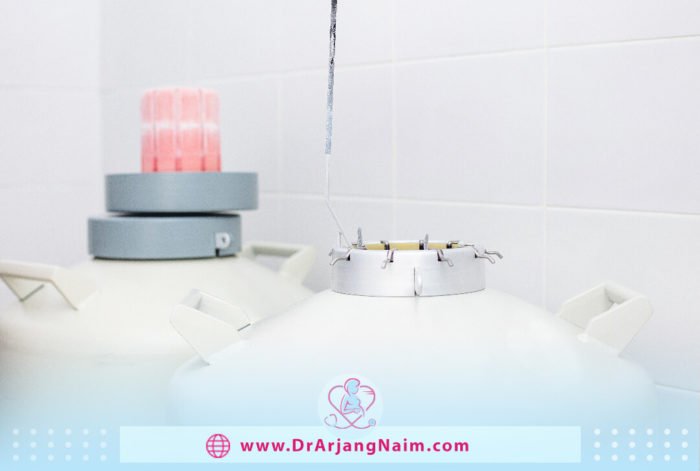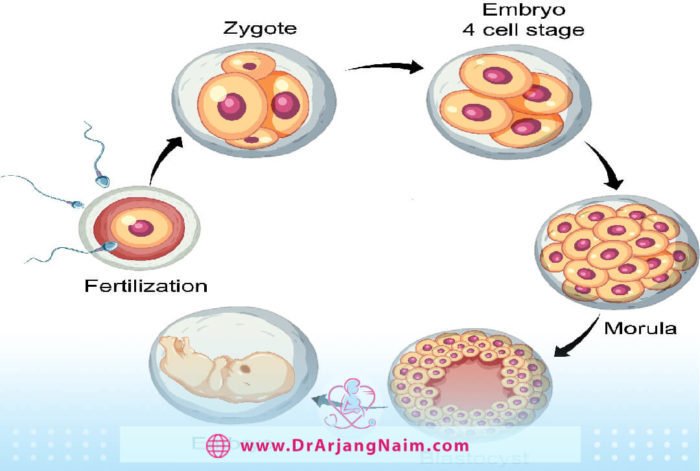Embryo freezing, also called embryo cryopreservation, is one of the methods of assisted reproduction and pregnancy, which includes the steps of freezing and maintenance and is performed by IVF or microinjection (ICSI) to allow future pregnancies. Embryo freezing is a method that allows people to store embryos for later use. One can also freeze unfertilized eggs. The embryo is formed after fertilization and after the onset of cell division.
The first successful pregnancy resulting from the freezing of a healthy fetus occurred in the 1980s. Since then, many people have frozen embryos and used them later. In this method, one or more embryos can be frozen, and, if necessary, the frozen embryos can be taken out of the frozen state and used.
What is an embryo?
The medical community uses the term fetus from the moment cells divide after fertilization until the eighth week of pregnancy. Appropriate embryos must be formed before freezing. . To do this in the laboratory, doctors must fertilize a number of eggs.
First, the woman takes hormones to make sure ovulation is on schedule. Fertility drugs are then used to increase the number of eggs they produce. In the hospital, the doctor extracts the eggs. During this operation, the mature eggs are viewed with the help of vaginal ultrasound and under anesthesia, then the puncture is done with the help of a thin needle.
A couple may want to freeze their eggs, or they may want to use them immediately to get pregnant. In this case, your doctor may recommend in vitro fertilization (IVF) or intracytoplasmic sperm injection (ICSI). During IVF, the doctor exposes the eggs to sperm and places them in a laboratory for fertilization. After this, the correct term for a fertilized egg is the embryo. An embryologist will monitor the development of the embryos for the next six days, after which they may select a suitable embryo for implantation.
During ICSI, the doctor extracts the eggs and injects sperm directly into the egg. They may do this if there is a problem with the sperm or if previous attempts at IVF have not resulted in fertilization. The doctor may use one embryo and freeze the rest.
How do embryos freeze?

The main purpose of embryo freezing is to preserve them for later use. The biggest challenge is the presence of intracellular water. When this water freezes, crystals can form and leave the cell.
Cryopreservation
To prevent this from happening, your doctor uses a process called cryopreservation. This involves replacing water in the cell with a substance called freezing.
The doctor then leaves the embryos to incubate in increasing levels of cryoprotectant before freezing them. After removing most of the water, the doctor cools the fetus to a state of preservation. Then they use one of two freezing methods:
- Slow freezing: This involves placing the embryos in sealed tubes and gradually lowering their temperature. It prevents the aging of embryonic cells and reduces the risk of injury. However, slow freezing is time-consuming and requires expensive machinery.
- Vitrification: The doctor quickly freezes the protected embryos so that the water molecules do not have time to form ice crystals. This helps protect the fetus and increases its survival rate during thawing.
After the cryopreservation process is complete, the physician stores the embryos in liquid nitrogen.
Side effects of embryo freezing

The fetuses can stay frozen until the right time for pregnancy. Embryo freezing complications or side effects usually occur when the doctor extracts the egg. Extraction’s common side effects are usually mild and temporary. These complications include:
- Cramping or bloating
- Feeling full
- Bleeding
- Changes in vaginal discharge
- Infection
- Overstimulation of the ovaries
How long can embryos stay frozen?
A frozen fetus can properly survive for any time. The embryos remain in sealed containers at -321 degrees Fahrenheit. At this temperature, almost no biological process like aging can occur. There are many successful pregnancies from eggs that people have stored for up to 10 years. Some countries adjust their fetal maintenance time.
Benefits of embryo freezing
Embryo cryopreservation is a better option for certain groups, such as:
- People who will soon undergo chemotherapy
- People who take medications that affect fertility
- People with genetic disorders that affect reproduction
- Women without a partner
- Infertility issues
Are frozen embryo transfers more successful?
Many fertility specialists and therapists believe that frozen embryo transfer is more successful in pregnancy than using fresh embryos in assisted reproduction techniques. However, the success rate is not the only determining factor. Depending on the circumstances, sometimes the transfer of fresh embryos may be more tailored to the needs of the parents.
The frozen embryo transfer process
When a woman prepares for pregnancy, the frozen embryo transfer process begins. This process begins with an ultrasound of the uterus to check its health. It may also be necessary to take medication to optimize the uterus lining for implantation.
When the doctor determines that the woman is ready for the frozen embryo transfer process, the doctor moves the embryo into the uterus. Usually, transferring only one to two embryos is recommended to reduce the risk of multiple pregnancies. The embryo transfer process is similar to a Pap smear. The doctor inserts a speculum into the vagina to keep the walls of the vagina open, then inserts a tube through the cervix and into the uterus. In this case, the doctor uses ultrasound for more accuracy. From there, the embryos pass through the tube and enter the uterus.
This process is usually painless. Some women may experience cramps after a frozen embryo transfer or discomfort due to speculum placement.
Is frozen embryo transfer successful?
Frozen embryo transfer occurs when the embryo is thawed and implanted in a woman’s uterus. This process is often successful. But rates vary widely based on many factors, including:
- Both parents’ overall health
- Mother’s age at the time of the egg retrieval
- Presence of fertility issues, such as endometriosis, fibroids, and uterine polyps
- Previous success or failure of fertility treatments and pregnancies
Why are only some embryos frozen?
Not all embryos grow well in the laboratory. Any embryos that have not grown well have a small chance of getting pregnant, so freezing all of them can create misconceptions for couples and increase costs.
Things to do after embryo transfer

Pregnancy success after an embryo transfer has very little to do with the precautions, but it can be effective.
Have more rest
After transplantation, there is hope for embryo implantation. Some doctors recommend that the mother rests for a few days longer than usual.
Keep taking medications
Many women need to take progesterone in the first few weeks after the transfer to have the best chance of continuing the pregnancy. Progesterone is an important hormone that is vital for maintaining pregnancy, which is why it is commonly used in assisted reproduction, such as IVF. This helps implant the embryo in the womb. Another medication doctor may recommend baby aspirin. No mother should stop taking her medication without consulting her doctor.
Eat a healthy diet
If all goes according to plan, the mother will raise a small person in her body for the next nine months. This is a great time to adopt healthy eating habits that experts recommend for pregnant women.
The mother should eat a variety of fruits and vegetables, as well as foods rich in calcium, protein, B vitamins, and iron.
Daily intake of folic acid supplement
There are many benefits to taking folic acid during pregnancy. Four hundred micrograms of this vitamin are needed to prevent neural tube defects. Maternal folic acid supplementation is associated with a reduced risk of congenital heart defects in infants and cleft lip and palate risk.
Pay attention to endocrine-disrupting chemicals
EDCs are chemicals that can interfere with the way hormones work in the body. Some EDCs cross the placenta. These chemicals can interfere with the growth of fetal organs in the womb. Exposure to high levels of these chemicals can cause other growth problems. For this reason, it is best for mothers not to consume products that contain substances such as bisphenol A (BPA), phthalates, parabens, and triclosan.
Things not to do
Some things should not be done after embryo transfer.
Have sex
It is best to have some pelvic rest after the embryo transfer. Sexual intercourse can cause uterine contractions, disrupting a fetus that has just been transferred to the body.
Take a pregnancy test right away
Most women are tempted to get an early pregnancy test. It may take several weeks from the day of transfer until the placental cells begin to produce enough of a hormone called human placental gonadotropin (hCG) to be detected by a blood test.
Ignore troubling symptoms
Women taking fertility drugs may develop a condition called Ovarian Hyperstimulation Syndrome (OHSS). This can happen when the body responds to injectable hormones that are consumed as part of the IVF process. OHSS can cause symptoms like:
- Abdominal pain
- Abdominal bloating
- Nausea
- Vomiting
- Diarrhea
If the symptoms are mild, they do not cause a problem, but you should see a doctor if they get worse.
The bottom line
Embryo freezing is the process of freezing and storing embryos for later use. An embryo is an egg fertilized by sperm. This process is a way to help people with fertility problems. Also, many people, at some point in life, for various reasons, such as working conditions or other issues, prefer to postpone their childbearing time to another time; the process of embryo freezing can allow them to become pregnant in the future. This process is relatively safe and often leads to a successful pregnancy and delivery.
Additional questions
1. What is a fetus?
After the end of the embryonic period, the embryo is considered a fetus at the end of the tenth week of pregnancy. The fetus of a baby is growing from the 11th week of pregnancy.
2. Which stage has the most risk of miscarriage?
The highest risk of miscarriage is in the early stages of pregnancy. It is estimated that 25% or more of pregnancies end in the early stages before a woman even knows she is pregnant or has missed her period. Most other miscarriages occur in the first 12 weeks of pregnancy when the fetus is growing.
3. What are the positive signs after the embryo transfer?
- Spotting
- Cramping
- Sore breasts
- Tiredness
- Nausea
- Bloating
- Discharge
- Increased urination
4. How many cells should be a three-day embryo?
Typically, a good embryo that grows on the third day has between 6 and 10 cells.
5. How many eggs are normally released at ovulation?
One egg is usually released each month during ovulation. But some women may release more than one egg in 24 hours. After ovulation, the mature egg is ready for fertilization by sperm.
References:
https://www.medicalnewstoday.com/articles/314662
https://www.hopkinsmedicine.org/health/treatment-tests-and-therapies/freezing-embryos
https://carefertility.com.au/treatments/embryo-cryopreservation-and-storage
https://laivfclinic.com/blog/8-tips-for-caring-for-yourself-right-after-embryo-transfer/
https://www.healthline.com/health/infertility/after-embryo-transfer-precautions
https://www.medicinenet.com/embryo_vs_fetus_differences_week-by-week/article.htm




